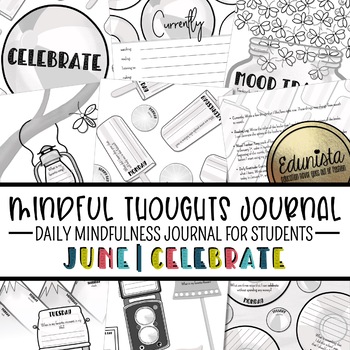Mindful Thoughts Journal: June/Celebrate Mindfulness Activities for Students
- Zip
- Google Apps™

Also included in
- Are you looking for a way to give your students the support they need to develop a growth mindset, increase their mindfulness and build important social emotional skills? Look no further than the Mindful Thoughts Bundle! This amazing bundle includes engaging journals that are designed to spark yourPrice $69.97Original Price $96.00Save $26.03
Description
Introducing the Mindful Thoughts Journal – a powerful tool for students to develop a growth mindset and improve their social-emotional learning. This journal is filled with daily mindfulness activities that are designed to be flexible and can be used any month of the year. Each month focuses on a different character education concept and encourages reflection to help students build important social-emotional skills.
The June edition of the journal focuses on the topic of celebration, and students will be prompted to think about who and what they want to celebrate, as well as different strategies for celebrating. Not only does this journal help students develop a growth mindset, but it also promotes a calm classroom environment by providing daily opportunities for students to reflect on their thoughts and actions and how they impact others.
The journal includes a variety of activities, such as a mood tracker, daily gratitude, and a reading log, as well as weekly spreads with prompts for writing and drawing. The journal also includes a reflection section, where students can think back on the work they've done and develop an action plan for the future.
Included Mindfulness Activities for Students:
★ Directions Spread with Glossary:
There is a small glossary on the Directions spread to help the students complete their Mindful Thoughts Journals independently. We have created the Directions spread as editable allowing you to tweak the directions to best fit your classroom and students.
★ Currently:
Here students will write a few things that they currently enjoy doing. These things will likely change from month to month. The Currently page is a fun keepsake to look back at throughout the year to see how students' likes and dislikes change as they grow.
★ Reading Log:
Here students will write the titles of books that they have read during the month. Students will enjoy tracking their books on this fun themed page.
★ Mood Tracker:
Here students will keep track of how they feel each day. They will color in today’s number with the color that represents how they feel today or felt yesterday depending on when you have your students complete their journals. We recommend having your students work on their Mindful Thoughts Journals in the morning as they are beginning their day and complete the mood tracker for the day before. Keeping track of how your students feel will help them to better understand their emotions, how those emotions are triggered, and how their emotions can influence their day.
★ Daily Gratitude:
Gratitude is about focusing on the good things in our lives and being thankful for what we have. Here students will write one thing that they are grateful for each day. According to Harvard Health Publishing, studies have shown that the practice of expressing gratitude each day "is strongly and consistently associated with greater happiness. Gratitude helps people feel more positive emotions, relish good experiences, improve their health, deal with adversity, and build strong relationships." In a world where everyone from our students to our teachers and administration are feeling stress, teaching self-care practices with mindfulness activities for students like gratitude journals are not only encouraged but essential.
★ Weekly Spreads:
Each two-page spread is designed and laid out a little differently but they all have some of the same pieces. Each spread will have a spot to write and draw each day. We recommend that the students write their answers in complete sentences and expand on their writing. For example, they can explain why. Remember these questions are just to get the students started thinking.
Each day also has a doodle section. This section is meant to be a quick drawing for students to practice their sketching skills, and creative skills and practice expressing themselves. Some spreads have extra doodle sections. We like to have our students complete those sections when they have extra time after they have completed their other work.
★ Reflection:
When the journal is complete, students can think back on the work they’ve done focusing on the theme for this month and develop an action plan for the future.
The journal can easily be used with Google Classroom, Seesaw, and other learning management systems, including downloadable images, Google Slides, and Google Drawings files. The Mindful Thoughts Journal can be printed back-to-back and bound in a three-ring binder, spiral-like binding, or with staples. We recommend the Swingline ProClip Binding System for a fast, cheap, easy to use, and professional-looking binding option.
The Mindful Thoughts Journal is a valuable tool for students to develop a growth mindset, improve their social-emotional learning, and create a calm classroom environment. Try the journal out in your classroom and see the positive impact it can have on your students.






